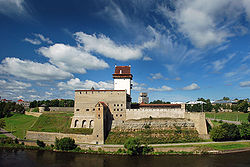
Hermann Castle
Encyclopedia

Castle
A castle is a type of fortified structure built in Europe and the Middle East during the Middle Ages by European nobility. Scholars debate the scope of the word castle, but usually consider it to be the private fortified residence of a lord or noble...
in Narva
Narva
Narva is the third largest city in Estonia. It is located at the eastern extreme point of Estonia, by the Russian border, on the Narva River which drains Lake Peipus.-Early history:...
, eastern Estonia
Estonia
Estonia , officially the Republic of Estonia , is a state in the Baltic region of Northern Europe. It is bordered to the north by the Gulf of Finland, to the west by the Baltic Sea, to the south by Latvia , and to the east by Lake Peipsi and the Russian Federation . Across the Baltic Sea lies...
. It was founded in 1256 by the Danes and the first stone castle was built in the beginning of the 14th century. The German Livonian Teutonic knights order
Livonian Order
The Livonian Order was an autonomous Livonian branch of the Teutonic Order and a member of the Livonian Confederation from 1435–1561. After being defeated by Samogitians in the 1236 Battle of Schaulen , the remnants of the Livonian Brothers of the Sword were incorporated into the Teutonic Knights...
purchased the castle on 29 August 1346 and for most of its history the castle was German Teutonic.
Medieval fortifications
Although the exact age of Narva Castle and the town cause still arguments between historians, they agree on the sequence of events. Firstly, in about the 13th century, the Danes, who had conquered Northern Estonia, built a wooden border stronghold at the crossing of the Narova River and the old road. Under the protection of the stronghold, the earlier settlement developed into the town of Narva, which obtained the Lubeck town rights in the first half of the 14th century. Following several conflicts with the Russians, the Danes started building a stone stronghold at the beginning of the 14th century. It was a small castellum-like building with 40-metre sides and a tower, a predecessor of the today's Herman Tower, at its north-western corner. At the beginning of the 14th century, a small forecourt was established at the north side of the stronghold and, in the middle of the century, a large forecourt was added to the west side, where citizens were allowed to hide in case of wars as the town of Narva was not surrounded by a wall during the Danish rule. In 1347 the Danish king sold Northern Estonia, including Narva, to the Livonian OrderLivonian Order
The Livonian Order was an autonomous Livonian branch of the Teutonic Order and a member of the Livonian Confederation from 1435–1561. After being defeated by Samogitians in the 1236 Battle of Schaulen , the remnants of the Livonian Brothers of the Sword were incorporated into the Teutonic Knights...
, who rebuilt the building into a convent building according to their needs. The stronghold has for the most part preserved the ground plan with its massive wings and a courtyard in the middle. The Herman Tower was also completed at the time of the Order, necessitated by the establishment of Ivangorod Castle
Ivangorod fortress
Ivangorod Fortress is a Russian medieval castle established by Ivan III in 1492 and since then grown into the town of Ivangorod....
by the Russians to the opposite side of the Narva River
Narva River
The Narva is a river flowing into the Baltic Sea, the largest river in Estonia. Draining Lake Peipsi, the river forms the border of Estonia and Russia and flows through the towns of Narva/Ivangorod and Narva-Jõesuu into Narva Bay. Though the river is only 77 km long, in terms of volume...
in 1492. The Order surrounded the town with a wall, which unfortunately has not been preserved (in 1777 there came an order to pull it down). On the basis of descriptions, we know that the wall had four gates: the Viru Gate in the west, the Herd (Karja) Gate in the north, the Old (Vana) Gate leading to the river port in the east and the Water (Vee) or Small (Vaike) Gate in the south. The gates were covered with iron plates and preceded by drawbridges. The town wall with a length of about a kilometre was fortified with at least seven towers. The town wall was surrounded by a moat. Towards the end of the Order's period, the town wall was supplemented, the gates were strengthened by adding foregates, and several medieval wall towers were adapted to use as special cannon towers or rondels, two of which can be seen today in their reconstructed shape in the corners of the castle's western court.

